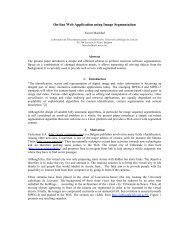motion estimation and compensation for very low bitrate video coding
motion estimation and compensation for very low bitrate video coding
motion estimation and compensation for very low bitrate video coding
Create successful ePaper yourself
Turn your PDF publications into a flip-book with our unique Google optimized e-Paper software.
Appendix C<br />
Markov R<strong>and</strong>om Fields<br />
The use of Markovian techniques in digital image processing is based<br />
on the possibility of modeling the image texture, the noise, <strong>and</strong> even<br />
some other criteria, like stochastic processes. Since their remarkable<br />
use in image restoration by Geman <strong>and</strong> Geman [39], the theory of<br />
Markovian processes [99] has been extended to Markov R<strong>and</strong>om Fields<br />
(MRF) [40], <strong>and</strong> their eld of application extended to images [137] <strong>and</strong><br />
<strong>motion</strong> elds [37, 109].<br />
The present appendix aims at giving a quick overview of MRF <strong>and</strong> the<br />
di erent concepts involved by their use. It will rst present Bayesian<br />
modeling, which is often related to MRF. Then, image description <strong>and</strong><br />
neighborhood relationship will introduce the de nition of MRF. The<br />
link with the Gibbs distribution is also tackled. Finally, the possible<br />
algorithms to solve the overall minimization problem are referred to.<br />
C.1 Bayesian Model<br />
Bayesian modeling assumes a priori statistical distribution <strong>for</strong> the solution<br />
of <strong>estimation</strong> problems. This a priori model (or prior model),<br />
p(u), is a probabilistic description of the solution u or of its properties<br />
be<strong>for</strong>e any sense data is collected.<br />
A second component, the sensor model (or likelihood model), p(dju),<br />
is a description of the noisy or stochastic processes that connects the<br />
original (unknown) state u to the sampled input image or sensor values,<br />
the data d. Using Bayes' rule, both can be combined in order to obtain<br />
an a posteriori model (or posterior model), p(ujd), which describes





